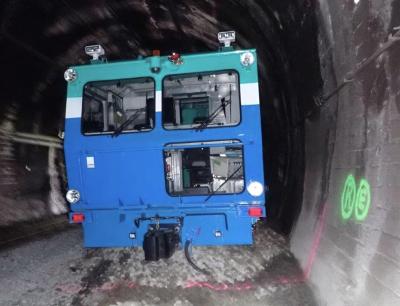Derailment of Tamper 703, Purewa tunnel, Auckland, 9 October 2023
Status
Closed
Occurrence Date
Report Publication Date
Jurisdiction
NZ
What happened
Just after midnight on 9 October 2023, the operator of a group of three track machines obtained permission for the machines to depart Westfield rail depot in Otāhuhu, Auckland and enter an area of line that was closed to rail traffic as part of the Rail Network Rebuild project. The area was controlled by a Rail Protection Officer (RPO).
The track machines were connected and running as a single unit, led by Tamper 703. It was intended that the machines would travel through the project area into Auckland.
As the group made its way through the project area, further permission to pass signals at red (stop) was required from train control in conjunction with the RPO.
Neither train control nor the RPO was aware that an area of track within the project area had been removed from within a tunnel along the route on which the tamper group was travelling.
When the tamper group entered the tunnel, the operator on Tamper 703 noticed the missing track and applied emergency braking.
Tamper 703 was unable to stop before driving off the end of the track and into ballast, where it travelled for 16.4 metres before stopping. The rear two machines were able to stop and remain on the track.
None of the four crew was injured, but Tamper 703 was significantly damaged.
Why it happened
Safety-critical information about the removal of the track within the project area was not provided to the track protection team because the key staff who were responsible were absent.
The track protection team did not have the resources to check all the track within the project area, and there was no requirement for track safety verification before rail traffic was authorised to move.
Key staff were unsupported while working in safety-critical roles and had very high work volumes.
What we can learn
Relying on administrative controls to prevent accidents and incidents may not be sufficient for safety-critical operations. Safety-critical systems requiring any human interactions should include protection and/or preventive engineering controls additional to those currently applied.
Who may benefit
Organisations and anyone responsible for managing or working within a safety-critical environment may benefit from the findings and recommendations in this report
Just after midnight on 9 October 2023, the operator of a group of three track machines obtained permission for the machines to depart Westfield rail depot in Otāhuhu, Auckland and enter an area of line that was closed to rail traffic as part of the Rail Network Rebuild project. The area was controlled by a Rail Protection Officer (RPO).
The track machines were connected and running as a single unit, led by Tamper 703. It was intended that the machines would travel through the project area into Auckland.
As the group made its way through the project area, further permission to pass signals at red (stop) was required from train control in conjunction with the RPO.
Neither train control nor the RPO was aware that an area of track within the project area had been removed from within a tunnel along the route on which the tamper group was travelling.
When the tamper group entered the tunnel, the operator on Tamper 703 noticed the missing track and applied emergency braking.
Tamper 703 was unable to stop before driving off the end of the track and into ballast, where it travelled for 16.4 metres before stopping. The rear two machines were able to stop and remain on the track.
None of the four crew was injured, but Tamper 703 was significantly damaged.
Why it happened
Safety-critical information about the removal of the track within the project area was not provided to the track protection team because the key staff who were responsible were absent.
The track protection team did not have the resources to check all the track within the project area, and there was no requirement for track safety verification before rail traffic was authorised to move.
Key staff were unsupported while working in safety-critical roles and had very high work volumes.
What we can learn
Relying on administrative controls to prevent accidents and incidents may not be sufficient for safety-critical operations. Safety-critical systems requiring any human interactions should include protection and/or preventive engineering controls additional to those currently applied.
Who may benefit
Organisations and anyone responsible for managing or working within a safety-critical environment may benefit from the findings and recommendations in this report

